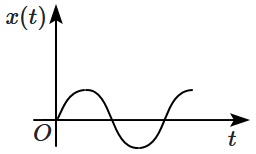The oscillation of a body on a smooth horizontal surface is represented by the equation, \(X=A \text{cos}(\omega t)\),
where \(X=\) displacement at time \(t,\) \(\omega=\) frequency of oscillation.
Which one of the following graphs correctly shows the variation of acceleration, \(a\) with time, \(t?\)
(\(T=\) time period) \(a~~O~~T~~t~~\)
1.

2.

3.

4.

where \(X=\) displacement at time \(t,\) \(\omega=\) frequency of oscillation.
Which one of the following graphs correctly shows the variation of acceleration, \(a\) with time, \(t?\)
(\(T=\) time period) \(a~~O~~T~~t~~\)




1. Only (IV) does not represent SHM
2. (I) and (III)
3. (I) and (II)
4. Only (I)
A particle of mass \(m\) is released from rest and follows a parabolic path as shown. Assuming that the displacement of the mass from the origin is small, which graph correctly depicts the position of the particle as a function of time?
| 1. |  |
2. |  |
| 3. |  |
4. |  |
1. \(\frac{\pi a\sqrt3}{2T}\)
2. \(\frac{\pi a}{T}\)
3. \(\frac{3\pi^2 a}{T}\)
4. \(\frac{\pi a\sqrt3}{T}\)
1. Acceleration = -k0x + k1x2
2. Acceleration = -k(x+a)
3. Acceleration = k(x+a)
4. Acceleration = kx
1. 1: 10
2. 1: 102
3. 1: 103
4. 1: 104
A point performs simple harmonic oscillation of period \(\mathrm{T}\) and the equation of motion is given by; \(x=a \sin (\omega t+\pi / 6)\). After the elapse of what fraction of the time period, the velocity of the point will be equal to half of its maximum velocity?
1. \( \frac{T}{8} \)
2. \( \frac{T}{6} \)
3. \(\frac{T}{3} \)
4. \( \frac{T}{12}\)
Two points are located at a distance of \(10\) m and \(15\) m from the source of oscillation. The period of oscillation is \(0.05\) s and the velocity of the wave is \(300\) m/s. What is the phase difference between the oscillations of two points?
1. \(\frac{\pi}{3}\)
2. \(\frac{2\pi}{3}\)
3. \(\pi\)
4. \(\frac{\pi}{6}\)
A particle executes simple harmonic oscillation with an amplitude a. The period of oscillation is T. The minimum time taken by the particle to travel half of the amplitude from the equilibrium position is:
1.
2.
3.
4.
1. \(0~\text{and}~2K_0\)
2. \(\frac{K_0}{2}~\text{and}~K_0\)
3. \(K_0~\text{and}~2K_0\)
4. \(K_0~\text{and}~K_0\)







